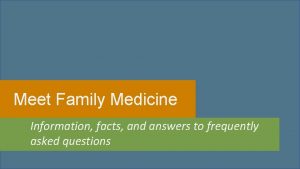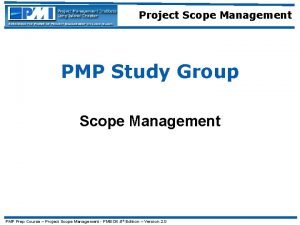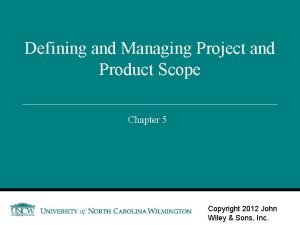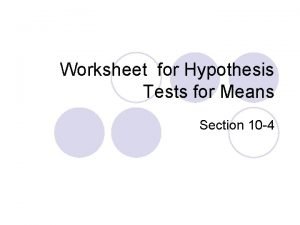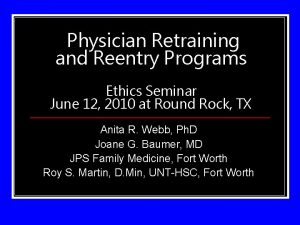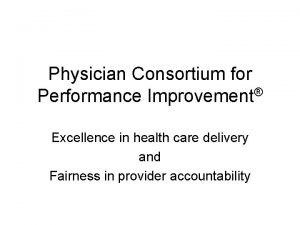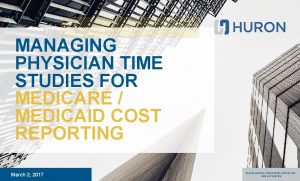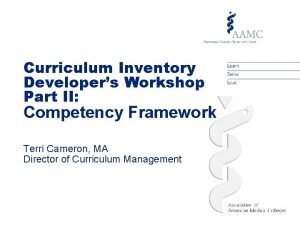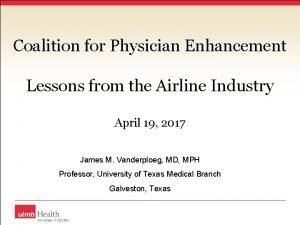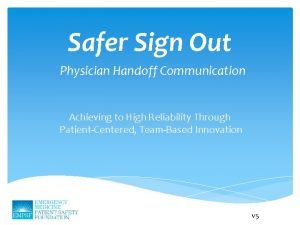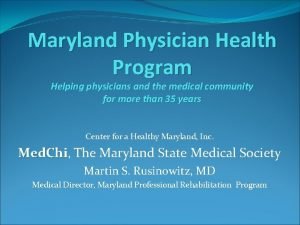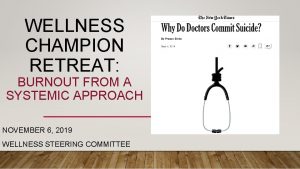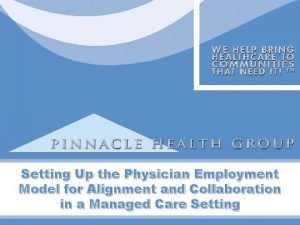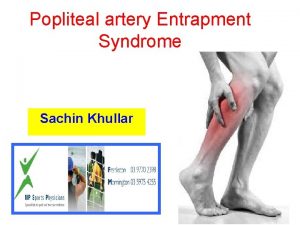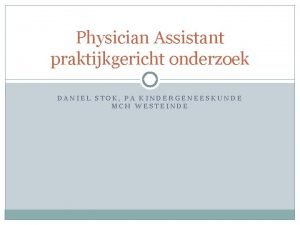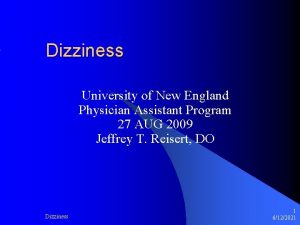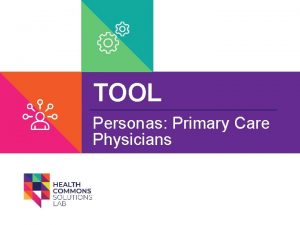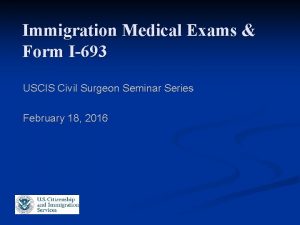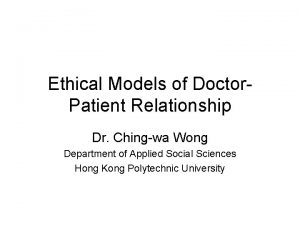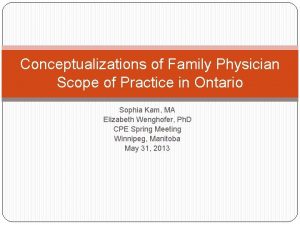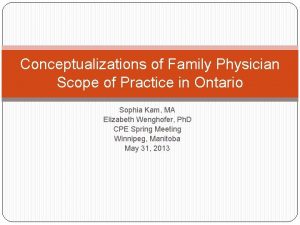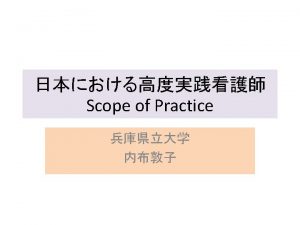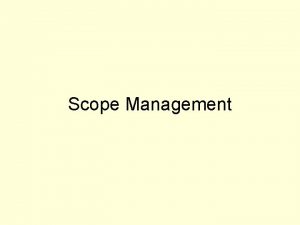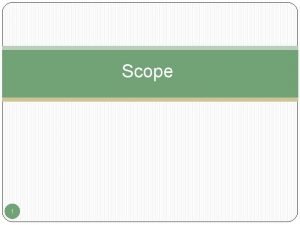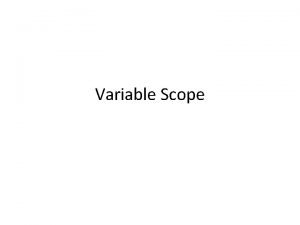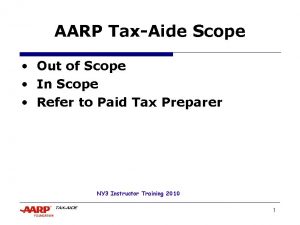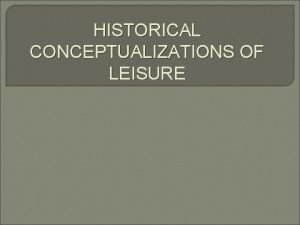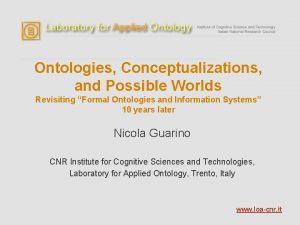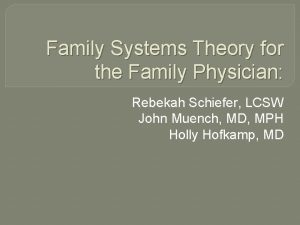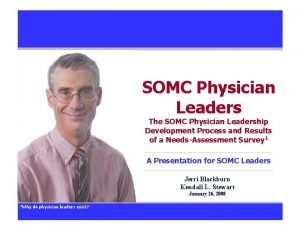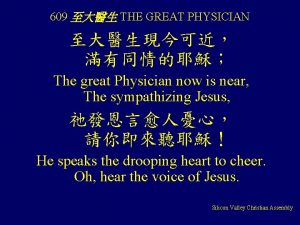Conceptualizations of Family Physician Scope of Practice in





















- Slides: 21

Conceptualizations of Family Physician Scope of Practice in Ontario Sophia Kam, MA Elizabeth Wenghofer, Ph. D CPE Spring Meeting Winnipeg, Manitoba May 31, 2013

Problem Statement � Physician scope of practice (SOP) perceived in various ways in different jurisdictions � Individual family physicians vs. legislators, medical regulators and educators (Baldwin et al. , 1999; Tulloh et al. , 2001; Probst et al. , 2002; Breon et al. , 2003) � Geography & variations in practice patterns (Jin et al. , 2003; Veugelers et al. , 2003; Konkin et al. , 2004; Hutten-Czapski et al. , 2004; Chan & Shultz. , 2005; Peterson et al. , 2005; CIHI, 2009) � Central to numerous elements of physician governance and practice (Norcini & Mazmanian, 2005, Health Force Ontario, 2006) � We don’t really know what SOP is (CPSO, DIALOGUE, Vol. 8 Iss. 1, 2012) � Assumption that SOP is entirely consistent with specialty certification (Melnick et al. , 2002; CPSO, DIALOGUE, Vol. 8 Iss. 1, 2012) � Changes in SOP throughout careers & assessment (Baldwin et al. , 1999; Tulloh et al. , 2001; Probst et al. , 2002; Breon et al. , 2003)

Hypotheses �There are two hypotheses: �(1) SOP is more than just education. It includes where physicians practice medicine (i. e. , it changes with the needs of their patient base, and the resources they may or may not have in their practice setting) �(2) Physician SOP will change over time, and will likely narrow as physicians grow older

Objectives �Broad - determine how different stakeholders concerned with various areas of physician governance and practice define and conceptualize family physician SOP in Ontario �Specific - determine the common conceptual elements of SOP, where the differences lie, and the implications of these commonalities and differences

Research Questions �(1)How is family physician SOP defined by/in: �(a) Ontario legislation? �(b) medico-legal liability issues? �(c) medical education? ; and �(d) professional regulations and licensing? �(2) How do individual family physicians define their SOP? �(3) What factors determine how family physicians define their SOP? �(4) How and why might these factors change?

Factors �Physician (Personal Provider) �Age �Gender �# of years in medical practice �Country in which medical training was received �Specialty certification �# of years practicing in their current setting

Cont’d �Organizational (Environmental) �Type of practice �Geographic setting/location �Patient base and associated needs �Available resources �Access to professional supports outside the primary practice setting �# of hrs/week in primary practice setting �# of patient visits/week in primary practice setting �Active hospital/teaching appointment �Focused SOP

Research Rationale �(1) Different practice scopes of family physicians, despite possessing common education and similar credentials (Smith & Hays, 2004; Wong & Stewart, 2010) �(2) Perspectives of SOP: medical profession vs. individual practitioners (Melnick et al. , 2002) �(3) Potential to redefine and reconceptualise SOP based on reassertions of factors influencing this concept in the literature (Klass, 2007)

Methods, Data Collection & Procedure � Purpose: Phase I �Evaluate how scope of practice is currently defined in regulatory and liability legislation �(TEXTUAL ANALYSIS VIA DOCUMENT REVIEWS) �PHASE I �Internet search of major federal and provincial policy statements on SOP (i. e. , MA, 1991; RHPA, 1991; AIT, 2012 – Ch. 7, CPSO Policy # 1 -08) �General search of medical literature re: definitions and concepts of term “SOP” via medical journals, books, internet �Literature search for concepts and definitions of SOP in different areas of physicians governance and practice

Cont’d �Purpose: Phase II �Examine current definitions of scope of practice in medical education, and professional governance and licensing �(DISCOURSE ANALYSIS, SEMI-STRUCTURED KEY INFORMANT INTERVIEWS, FOCUS GROUPS) �PHASE II �Semi-structured key informant interviews & focus groups �Federal and provincial medical associations (i. e. , CMPA, CMA, OMA) �Regulatory bodies (i. e. , FMRAC, CPSO) �Certification bodies (i. e. , CFPC) �Education bodies (i. e. , AMFC)

Cont’d � Purpose: Phase III & Phase IV �Assess how individual family physicians conceptualize their own practice scopes �Assess what factors influence this �Assess how and why these factors might change � PHASE III �Survey designed � 2 week pilot test of survey instrument �Distributed & administered mail and online � 8 weeks from initial distribution to date of reply �Dillman’s Tailored Design Method – weeks 3 and 6 (Dillman, 2007)

Cont’d � Sample �Probability sampling (oversampling northern Ontario) � 4000 Ontario family physicians (CMA Masterfile, January 2012) �Approx. 600 responses estimated (~15%) � Inclusion Criteria �(1) Family physicians �(2) Completed the 2013 CPSO Annual Membership Renewal Survey �(3) Have a license to practice independently �(4) In independent practice for at least 5 years �(5) In “good standing” �(6) Primary practice address is in Ontario �(7) Consented to participate in this study

Cont’d �Exclusion Criteria �(1) RCPSC certified specialists not holding a license to practice family medicine �(2) Physicians who do not wish for their data to be released will be preliminarily excluded from the CPSO data feed �PHASE IV �Post-eight week period �Returned surveys examined �Rural practicing participants contacted & invited to further participate in follow-up focus groups

Data Analysis Plan – Quantitative Data �Part I �Descriptive analysis re: factors physicians use themselves (e. g. , Patients seen? Diseases treated? Practice structure, geographic location, etc? ) �SPSS – Descriptive statistics re: non-parametric items (demographic, “yes”/“no” questions). Frequencies re: most identified/popular definitions �Part II �Parametric testing, logistic regression re: perceptions of breadth of practice scopes (e. g. “above average, ” “about right/on par, ” “more focused”) – outcome variable

Study Limitations �The influence of legislation and other policies and regulations that impact physician SOP will be jurisdictionally specific �Specific practice contexts in areas not included in the study may differ. Results may have limited applicability for those areas �Defining the scope of a profession is difficult & defining SOP with any level of detail may be impossible (CPSO, DIALOGUE, Vol. 8 Iss. 1, 2012) �An attempt to define SOP may be more feasible for specialties other than family medicine (CPSO, DIALOGUE, Vol. 8 Iss. 1, 2012)

Regulator Considerations Re: Defining/Limiting SOP � Feedback from CPSO consultation with profession includes: �Potentially good for public protection �Could help with resource planning �Must account for different practice needs in northern and rural areas �Would such an endeavour make a difference? �Concern that a consequence could be to limit SOP more narrowly � (CPSO, DIALOGUE, Vol. 8 Iss. 1, 2012) � Unintended consequences of defining SOP too narrowly? � Breadth vs. depth of knowledge expected of physicians & accountability (Melnick et al. , 2002; Klass, 2007)

Relevance & Implications of Expected Results �This study will challenge current concepts of SOP �Have direct relevance for quality of care � Baldwin et al. , 1999; Tulloh et al. , 2001; Probst et al. , 2002; Breon et al. , 2003 �This study can address the lack of clarity regarding the concept of SOP �Contribute to public consultations within Ontario’s medical profession �Numerous practical and policy implications of this research

When Conducting this Research, the Following Will be Encouraged… �The methods encourage: �Physicians to personally conceptualize SOP (may differ from medical regulators and educators) �A balanced perspective of SOP with an emphasis on physician voices �The generation of a practice and evidence informed definition of SOP to be considered in legislation and medical education

References � � � Baldwin, L. M. , Rosenblatt, R. A. , Schneeweiss, R. , Lishner, D. M. , & Hart, L. G. (1999). Rural and urban physicians: Does the content of their medicare practices differ? Journal of Rural Health, 15(2): 240 -251. Breon, T. A. , Scott-Conner, C. E. , & Tracy, R. D. (2003). Spectrum of general surgery in rural Iowa. Journal of Current Surgery, 60(1): 94 -99. Canadian Institute for Health Information. (2009). Health Indicators. Ottawa, ON: CIHI, 1 -138. Canadian Medical Association. (January 2012). CMA masterfile: Number of physicians by province/territory and specialty, Canada, 2012. Ottawa: Canadian Medical Association. Retrieved from: http: //www. cma. ca/multimedia/CMA/Content_Images/Inside_cma/Statistics/01 Spec&Prov. pdf. Chan, B. T. & Shutlz, S. E. (2005). Supply and utilization of general practitioner and family physician services in Ontario: ICES Investigative Report. Toronto: Institute for Clinical and Evaluative Sciences. College of Physician and Surgeons of Ontario (2012). “Defining Scope of Practice: College Explores possible solution to “practice drift. ” Dialogue, Vol. 8, Iss. 1: 9 -12. Dillman, D. A. (2007). Mail and internet surveys: The tailored design method. Second edition. New York, New York: John Wiley & Sons, Inc. Health Force Ontario. (2006). Entry to practice requirements for health care professionals outside Ontario. Retrieved from: http: //www. healthforceontario. ca/Work/Outside. Ontario/Physicians. Outside. Ontario/Practice. Requirements. aspx. Hutten-Czapski, P. , Pitblado, R. , Slade, S. (2004). Short report: Scope of family practice in rural and urban settings. Canadian Family Physician, 50: 1548 -1550. Jin, Y. , Marrie, T. J. , Carrier, K. C. , Predy, G. , Houston, C. , Ness, K. & Johnson D. H. (2003). Variation in management of community-acquired pneumonia requiring admission to Alberta, Canada hospital. Epidemiol Infect. , 130(1): 45 -51. Klass, D. (2007). A performance-based conception of competence is changing the regulation of physicians’ professional behaviour. Academic Medicine, 82(6): 529 -535.

References � Konkin, J. , Howe, D. & Soles, T. L. (2004). Society of Rural Physicians of Canada, SRPC � � � � Policy Paper on Regionalization. Canadian Journal of Rural Medicine, 9(4): 257 -259. Melnick, D. E. , Asch, D. A. , Blackmore, D. E. , Klass, D. J. , & Norcini, J. J. (2002). Conceptual challenges in tailoring physician performance assessment to individual practice. Medical Education, 36: 931 -935. Norcini, J. J. , & Mazmanian, P. E. (2005). Physician migration, education, and health care. Journal of Continuing Education in the Health Professions, 25(1): 4 -7. Peterson, S. , Shapiro, E. & Roos, N. P. (2005). Regional variation in home care use in Manitoba. Can J Aging, 24 Suppl 1: 69 -80. Probst, J. C. , Moore, C. G. , Baxley, E. G. , & Lammie, J. J. (2002). Rural-Urban differences in visits to primary care physicians. Fam Med. , 34(8): 609 -615. Smith, J. , & Hays, R. (2004). Is rural medicine a separate discipline? Australian Journal of Rural Health, 12: 67 -72. Tulloh, B. , Clifforth, S. , & Miller, I. (2001). Caseload in rural general surgical practice and implications for training. ANZ Journal of Surgery, 71(4): 215 -217. Veugelers, P. J. , Yip, A. M. & Elliot, D. C. (2003). Geographic variation in health services use in Nova Scotia. Chronic Dis. Can. 24(4): 116 -123. Wong, E. , & Stewart, M. (2010). Predicting the scope of practice of family physicians. Canadian Family Physician, 56: e 219 -e 225.

Thank You! � Questions? �I would greatly appreciate your feedback! �skam@laurentian. ca �sophie. kam@alumni. utoronto. ca
 Family medicine procedures
Family medicine procedures Scope management pmp
Scope management pmp Product scope vs project scope
Product scope vs project scope A physician claims that joggers maximum volume
A physician claims that joggers maximum volume Physician reentry program
Physician reentry program Physician consortium for performance improvement
Physician consortium for performance improvement Physician time studies
Physician time studies Physician segmentation methodology
Physician segmentation methodology Physician competency reference set
Physician competency reference set Coalition for physician enhancement
Coalition for physician enhancement Jeannie watkins
Jeannie watkins Physician sign out
Physician sign out Elisha prayer eagles
Elisha prayer eagles Maryland physician health program
Maryland physician health program Physician burnout retreat
Physician burnout retreat Physician employment models
Physician employment models Sachin khullar
Sachin khullar Daniel stok
Daniel stok University of new england physician assistant program
University of new england physician assistant program Physician personas
Physician personas Uscis civil surgeon locator
Uscis civil surgeon locator Non malficence
Non malficence
